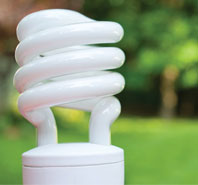Ten Easy Steps on the Road to Sustainability
Living “green” is an ideology most people share; however, the concept must be put into practice for real change to occur. The way to change begins with adjusting your mindset, rethinking how to look at things and understanding the interconnection between environment and life. After some practice, this thought process will become commonplace and you’ll wonder why you didn’t start on the road to sustainability sooner, especially because it’s the “right thing to do” and it saves money.
Below you’ll find 10 ways to begin this journey, if you haven’t done so already. If you have, then use this as a checklist to make sure you didn’t miss any of the easy things. Regardless, we’re sure this road will take you to a place, metaphorically or physically, where you and your family can “live better.”
1. Switch from plastic bags to bags made from cloth, soy, paper or cornstarch.
Traditional plastic bags are dual offenders because they are made from petroleum and do not truly biodegrade. As a result, in March 2007 San Francisco, Calif., became the first major U.S. city to mandate that larger retailers use biodegradable bags, including plastic bags made from soy or cornstarch. Numerous states and countries, such as Alaska, Great Britain, South Africa, Ireland, Bangladesh, Taiwan and China, have initiated similar legislation. Even large food retailers in Lhasa, Tibet, automatically provide cloth bags at check-out in an effort to protect their environment.
If you live elsewhere, you still can make a difference by asking for paper bags or bringing reusable cloth shopping bags. Both are biodegradable, typically able to hold a greater volume of products; and they don’t tear like plastic bags. Biodegradable plastic bags used for trash can liners, food storage and pet needs can be purchased via the Internet from vendors such as BioGroupUSA (www.biobagusa.com).
2. Switch from incandescent light bulbs to compact fluorescent light (CFL) bulbs.
Although compact fluorescent light bulbs cost more initially, each one provides about 6,000 to 12,000 hours of use in comparison to the 700 hours of use incandescent bulbs provide. Therefore, they actually provide consumers substantial savings in the long run while using about 75 percent less electricity – a huge benefit to the environment as well as to the pocketbook.

© iStockphoto.com/edelmar
For instance, based on an average cost of 10 cents per kilowatt hour, if you currently use ten 60-watt incandescent light bulbs and five 90-watt outdoor bulbs, you would save about $112 per year by switching to CFLs and about $616 over the lifetime of the CFLs.
If you are a “CFL beginner” the switch can be a little confusing because CFL wattage differs from traditional incandescent bulb wattages. For example, a 13– to 15-watt CFL is the equivalent of a 60-watt incandescent bulb; and, a 16- to 29-watt CFL is the equivalent of a 100-watt incandescent bulb. In addition, make sure you choose the right CFL for the right purpose because CFLs are shaped differently. Log onto www.gelighting.com for more information or to use General Electric’s Energy-Smart CFL Savings Calculator.
3. Buy locally grown organic food whenever possible.
Buying locally grown organic food not only tastes better and costs less, but also helps boost local economies, to include supporting local farmers. In addition, because organic food is grown without the use of pesticides, fewer chemicals are released into the environment which includes water supplies. Buying local also reduces greenhouse gases (GHG) because significantly less petroleum products are used to transport the food to market.
Farmers’ markets are wonderful places to find locally grown, quality food. Before you buy, be sure to ask about the use of pesticides and chemicals to confirm the food is organic. Small farmers often cannot afford organic certification yet their produce or products may still be organic. Seek out food grown or reared by Future Farmers of America or 4-H members because supporting local education programs helps support your community, your neighbors and your children.
Organic foods also are available in many grocery stores. Look for a U.S. Department of Agriculture (USDA) organic label. Only foods that are 95 to 100 percent organic may use the USDA Organic Seal. Products with labels reading “made with organic ingredients” include from 70 to 94 percent organic ingredients. For more information about the distinctions in organic food labeling and USDA requirements for organic foods, go to www.ams.usda.gov.
4. Plug appliances into power strips and unplug power strips when not in use.
The U.S. Department of Energy (DOE) states that “electricity generated by fossil fuels for a single home puts more carbon dioxide into the air than two average cars.” Many experts agree that the biggest home energy drains are household appliances and technology because even though these products may be turned off, they still use electricity.
Appliances on standby continuously draw power as do cell phone chargers, printers and videogames. DOE data shows that 75 percent of the electricity used to power home electronics is consumed while the products are turned off. As a result, the DOE’s energy saver tips recommend plugging computers, appliances, cell phone chargers, TVs and DVD players into power strips and unplugging the power strips when not in use. You’ll get the added benefits of protecting your technology in the event of power surges while reducing your carbon footprint and your energy bill.
5. Conserve water and energy by washing only full loads of dishes and clothes.
Washing only full loads of dishes and clothes will conserve water and save energy. Furthermore, allowing dishes in the dishwasher to air-dry, using only cold water to wash clothes and using a drying rack or clothesline to dry clothes whenever possible also reduces your energy bill.

© iStockphoto.com/ducan1890
To really save on water and energy, switch to an Energy Star-endorsed clothes washer, and dryer which uses 35 to 50 percent less water and 50 percent less energy.
If you live in a rural area and have a well, the most efficient washers and dryers, like the LG Tromm SteamWasher and Dual Humidity Sensors Dryer, are a dream come true. They use 90% less electricity and 90% less water (and clean unbelievably large loads while being ultra-quiet). No more worrying about the well going dry when you wash clothes during a summer drought. The upfront cost of an LG Tromm is significantly higher, but the convenience factor and the energy and water savings are phenomenal.
6. Switch to low-flow aerating shower heads and low-flush toilets.
United States households use an average of 400 liters of water per day, which is 40 times more than the world-wide average and twice as much as consumed in Europe. Flushing toilets actually consume one-quarter of this water usage. Switching to bathroom appliances that consume less water will create significant water savings without any conscious effort or loss of comfort. For example, replacing an older model toilet with Kohler’s Cimarron™ Comfort Height™ 1.28 gpf toilet with Class Five™ EcoSmart™ (EST) technology can save up to 3,200 gallons of water per year. Add on low-flow shower heads, such as Kohler’s MasterShower® showerhead and handshower, and you can save an additional 20% while maintaining reliable water pressure and temperature. Conserving water today means more water for the future, plus it also saves on water bills.
7. Find alternative methods to supplement heating and cooling your home.
A 1-degree decrease in the thermostat saves an average of 1 percent on a heating bill, while a 1-degree increase in the thermostat saves on the summer cooling bill. One way to accomplish this reduction and still stay comfortable is to use ceiling fans. Add a ceiling fan with a directional switch to each high-use room of the house and watch your energy bill go down while your comfort goes up.
Turn the switch in the winter so that the fan propels the air downward for better distribution of heat. Do the opposite in the summer so you can turn the thermostat up and the air conditioner down. Augment the ceiling fan’s cooling effect by using automatic blinds to block out the sun during the hottest part of the day. Or, why not turn the air conditioner off completely and open the windows on opposite ends of the house for crossventilation. This simple act, in conjunction with your ceiling fans, will not only cool the house on most summer days, but also provide healthier air for you and your family to breathe. Whichever options you consider, maintain furnaces, air conditioners and heat pumps; and, replace filters as recommended.
8. Update your appliances to Energy Star-endorsed products.
Newer appliances, especially those with Energy Star labels, use less energy than older models. According to the Energy Star website (www.energystar.gov), “qualified appliances incorporate advanced technologies that use 10-50 percent less energy and water than standard models. The money you save on your utility bills can more than make up for the cost of a more expensive but more efficient Energy Star model.”
For instance, an Energy Star-endorsed refrigerator uses 40 percent less energy than a conventional 2001 model. Additionally, if you replace a 1990 refrigerator with a newer Energy Star model, you may save enough in electric bills to light the average household for four months. To really maximize your appliances’ performance, make sure to use the energy-saving settings.
9. Be kind to your car.
Driving aggressively and at high speeds consumes more gasoline than driving calmly at or under the speed limit. For instance, each 5 mph above 60 mph can cost you about 20 cents per gallon. According to the Alliance to Save Energy (www.ase.org), speeding, rapid acceleration and braking can lower gas mileage by 33 percent at highway speeds and 5 percent around town. In addition, servicing your car at recommended intervals, changing the oil, getting tune-ups and taking care of your tires will increase the fuel economy of your vehicle. Replacing a faulty oxygen sensor can increase fuel economy by 40 percent. And just tuning up your car can increase your fuel economy up to 4 percent.
To maximize fuel economy, carpool, take public transportation, walk or ride a bicycle whenever possible. Take a risk and change some of your personal transportation patterns. You’ll be amazed at the dollar savings you’ll reap while enjoying the freedom of not being glued to the car everyday.
10. Recycle.
Each person in the United States produces about 4.4 pounds of waste per day, according to the U.S. Environmental Protection Agency (www.epa.gov). Roughly 30 percent of this waste is recyclable.
Recycling greatly reduces the amount of garbage in landfills and in the oceans while simultaneously helping manufacturers use fewer natural resources. According to the EPA, using recycled materials makes a big difference in this country since “waste prevention has environmental benefits, including reduced energy consumption and pollution, conservation of natural resources and extension of valuable landfill capacity.” To find the nearest recycling facility and to learn which materials you can recycle, visit www.earth911.org or call 1-877-EARTH911.
These 10 steps reinforce the premise that to ensure the environmental health of our planet and our families we can no longer afford to pretend that our actions do not have consequences. We, as consumers and energy demanders, have created a Pandora’s Box of health issues and environmental catastrophes. Until we decide to conserve resources and to demand healthier, cleaner and greener energy options, we will continue to pollute the Earth and devastate its inhabitants. We have the power to make this change and the time is now. Become more involved by supporting legislators who advocate sustainable environmental policy. Write to your congressman and demand real change in order to create a sustainable future for you, your family and your planet. Take a stand now because, like it or not, sustainability is a life issue





























